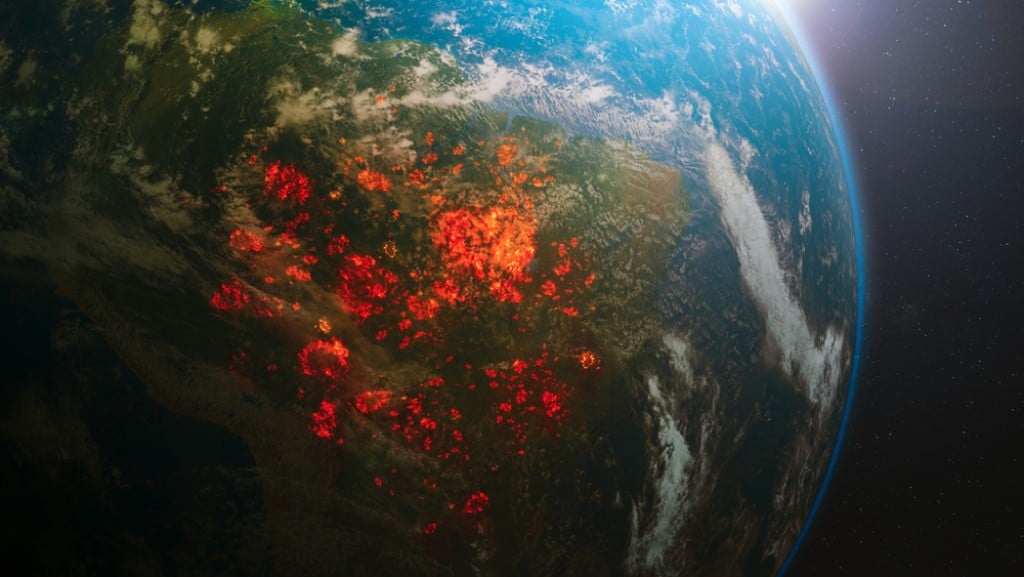Southern tropics wildfire season shows contrasting patterns, says Copernicus
- November 7, 2023
- 11:02 am


Iain Hoey
Share this content
Variability in wildfire emissions across southern hemisphere tropics
The Copernicus Atmosphere Monitoring Service (CAMS) has identified a contrasting pattern in wildfire activity across the southern hemisphere’s tropical regions, with Australia facing increased fire intensity, while South America and Indonesia are experiencing less than average fire emissions.
Australia faces highest wildfire emissions since 2012
Australia’s fire season began with an escalation in intensity from September, with significant emissions recorded.
The fires peaked in October, particularly impacting Western Australia, Northern Territory, Queensland, and New South Wales.
Australia has now reported its highest carbon emissions from wildfires since 2012, with a current estimate of around 110 megatonnes between August and October, and fires still active in various regions.
South America sees mixed wildfire activity despite drought
While South America is under the stress of drought conditions, fire emissions have been generally low.
Brazil’s emissions have dipped to the lowest since 2019.
However, parts of Northern Argentina, Paraguay, and Bolivia have seen significant wildfire occurrences.
In Bolivia, carbon emissions from wildfires reached approximately 15 megatonnes in October, marking the highest for the month in over two decades.
Indonesian wildfire emissions remain low in face of El Niño
Despite the usual risk factors such as El Niño and a positive Indian Ocean Dipole enhancing drier and more fire-prone conditions, Indonesia’s wildfire emissions from August to October have been below average.
The country is trending similarly to its pattern over the past three years, according to CAMS data, although historically El Niño and positive IOD years have led to increased emissions.
Copernicus highlights the importance of emissions monitoring
Mark Parrington, a senior scientist at CAMS, underscored the importance of their monitoring work: “The predictions for El Niño this year have given us extra incentive for our emissions monitoring around the southern tropics since the beginning of August.
“We have observed increased fire emissions from Indonesia and the Amazon relative to recent years.
“While not reaching the extreme levels of the previous El Niño years, they have still produced significant amounts of smoke and degradation of air quality.
“The monitoring work we do in CAMS is essential for understanding the potential atmospheric impacts of fire emissions such as these when they are occurring.”
About Copernicus Atmosphere Monitoring Service
The Copernicus Atmosphere Monitoring Service is a cornerstone of the European Union’s Earth observation programme, providing comprehensive data on atmospheric composition and dynamics.
Implemented by the European Centre for Medium-Range Weather Forecasts, it offers vital services for monitoring wildfires and assessing their impact on air quality and climate.
For more information about the contrasting wildfire season in the southern hemisphere, read the full analysis here: Southern tropical wildfires: A picture in contrasts.
Access the CAMS Global Fire Monitoring resources here: Global Fire Monitoring.
Further details about fire monitoring are available on the CAMS Wildfire Q&As page: Wildfire Q&As.
IFSJ Comment
The recent findings by CAMS underscore the varying impacts of climate events like El Niño on wildfire seasons.
The monitoring of these variations is critical for preparedness and response efforts globally.
Fire management agencies and environmental scientists rely on accurate and timely data to strategise on firefighting and mitigation efforts.
The disparity in fire emissions between continents also highlights the unpredictable nature of wildfire incidents, stressing the need for international collaboration and the sharing of knowledge and resources to combat these natural disasters effectively.
With climate patterns increasingly affecting fire behaviour, the work of CAMS becomes not only relevant but necessary for global environmental health and safety.



